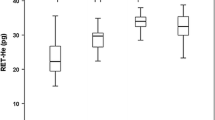Abstract
Iron deficiency and iron deficiency anemia are common conditions in children, especially in developing countries. It is often difficult for the pediatrician to know which indices should be used in the diagnosis of these conditions in children. Reticulocyte hemoglobin (Hb) content (CHr) has been shown to be an accurate indicator of anemia, however whether its use suits the situation in developing countries or not is unclear. The aim of this study was to evaluate the value and effectiveness of using CHr as a method to diagnose iron deficiency and iron deficiency anemia in Saudi children. The samples for the study were collected from 305 children suspected to have anemia. Complete blood count, transferrin saturation (Tfsat), ferritin, circulating transferrin receptor (TfR) and CHr were measured. Three groups were defined, iron deficiency (Tfsat <20%, Hb >11 g/dL; n=120), iron deficiency anemia (Tfsat <20%, Hb <11 g/dL; (n=73) and controls (Tfsat >20%; n=112). The anemic group had significantly lower macrocytic anemia (MCV), mean corpuscular hemoglobin (MCH) and CHr. All of the variables in the anemia group were significantly lower than those of the control group except for the ferritin level. Compared to the control group, the iron deficiency group also showed significantly lower values except for transferrin receptor and the ferritin levels. CHr levels of <26 pg correlated well with anemic states. CHr together with a complete blood count may provide an alternative to the traditional hematologic or biochemical panel for the diagnosis of iron deficiency and iron deficiency anemia in young children and is cost-effective in developing countries. A CHr cut-off level of 26 pg is considered to be a reasonable indicator of anemic states.
Similar content being viewed by others
Abbreviations
- Hb:
-
Hemoglobin
- CBC:
-
Complete blood count
- CHr:
-
Reticulocyte hemoglobin
- Tfsat:
-
Transferrin saturation
- TfR:
-
Transferrin receptor
- ZPP:
-
Zinc protoporphyrin
References
Al-Awamy BH (2000) Thalassemia syndromes in Saudi Arabia. Meta-analysis of local studies. Saudi Med J 21:8–17
Breymann C, Anaemia Working Group (2001) Current aspects of diagnosis and therapy of iron deficiency anemia in pregnancy. Schweiz Rundsch Med Prax 90:1283–1291
Brugnara C, Lauter MR, Friedman AJ, Bridges K, Platt O (1994) Reticulocyte hemoglobin content (CHr): early indicator of iron deficiency and response to therapy. Blood 83:3100–3101
Brugnara C, Zurakowski D, DiCanzio J, Boyd T (1999) Reticulocyte hemoglobin content to diagnose iron deficiency in children. J Am Med Assoc Pediatr 281:2225–2230
Cazzola M, Mercuriali F, Brugnara C (1997) Use of recombinant human erythropoietin outside the setting of uremia. Blood 89:4248–4267
d’Onofrio G, Zini G, Ricerca BM, Macini S, Mango G (1992) Automated measurement of red blood cell microcytosis trait. Arch Lad Med 116:84–89
Dallman PR, Reeves JD, Driggers DA (1981) Diagnosis of iron deficiency: the limitations of laboratory tests in predicting response to iron treatment in 1-year old infants. J Pediatr 98:376–381
Fishbane S, Galgano C, Langley RC, Canfield W, Maesaka JK (1997) Reticulocyte hemoglobin content in the evaluation of iron status of hemodialysis patients. Kidney Int 52:217–222
Freguston BJ, Simpson KM, Baynes RD, Cook JD (1992) Serum transferrin receptor distinguishes the anemia of chronic disease from iron deficiency anemia of chronic disease from iron deficiency anemia. J Lab Clin Med 19:385–390
Guyatt GH, Oxman AD, Ali M, Willan A, McIlroy W, Patterson C (1992) Laboratory diagnosis of iron-deficiency anemia: an overview. J Gen Intern Med 7:145–153
Hallberg L, Bengtsson C, Lapuid L, Lindstedt G, Lundberg PA, Hulten L (1993) Screening for iron deficiency: an analysis based on bone-marrow examinations and serum ferritin determinations in a population sample of women. Br J Haematol 85:787–798
Kotisaari S, Romppanen J, Penttila I, Punnonen K (2002) The Advia 120 red blood cells and reticulocyte indices are useful in diagnosis of iron-deficiency anemia. Eur J Haematol 68:150–156
Lafferty JD, Crowther MA, Ali MA, Levine M (1996) The evaluation of various mathematical RBC indices and their efficacy in discriminating between thalassemic and non-thalassemic microcytosis. Am J Clin Pathol 116:84–89
Looker AC, Dallman PR, Carroll MD, Gunter EW, Johnson CL (1997) Prevalence of iron deficiency in the united states. JAMA 277:973–976
Lozoff b, Jimenez E, Wolf A (1991) Long-term developmental outcome of infants with iron deficiency. N Eng J Med 325:687–694
Massey AC (1992) Microcytic anemia: differential diagnosis and management of iron deficiency anemia. Med Clin North Am 76:549–566
Mast AE, Blinder MA, Gronowski AM, Chumley C, Scott MG (1998) Clinical utility of the soluble transferrin receptor and comparison with serum ferritin in several populations. Clin Chem 44:45–51
Mast AE, Blinder MA, Lu Q, Flax S, Dietzen DJ (1998) Clinical utility of the reticulocyte hemoglobin content in the diagnosis of iron deficiency. Blood 99:1489–1491
Oski FA (1993) Iron deficiency in infancy and childhood. N Eng J Med 329:190–193
Root CB (1998) Medicare coding and reimbursement for clinical laboratory services. Clin Chem 44:1713–1727
Ruivard M, Gerbaud L, Doz M, Philippe P (2002) Ferritin is more cost-effective than transferrin receptor-ferritin index for the diagnosis of iron deficiency. Arch Intern Med 62:1783
Tsimmerman IS, Babushkina GD (1997) Diagnosis and differential diagnosis of iron deficiency anemia. Klin Med 75:71–75
Vydyborets SV (2001) Iron metabolism: methods for the diagnosis of abnormalities. Current approaches for the treatment of iron-deficiency anemia. Review of the literature and case histories. Lik Sprava 2:9–17
Author information
Authors and Affiliations
Corresponding author
Rights and permissions
About this article
Cite this article
Bakr, A.F., Sarette, G. Measurement of reticulocyte hemoglobin content to diagnose iron deficiency in Saudi children. Eur J Pediatr 165, 442–445 (2006). https://doi.org/10.1007/s00431-006-0097-0
Received:
Accepted:
Published:
Issue Date:
DOI: https://doi.org/10.1007/s00431-006-0097-0




